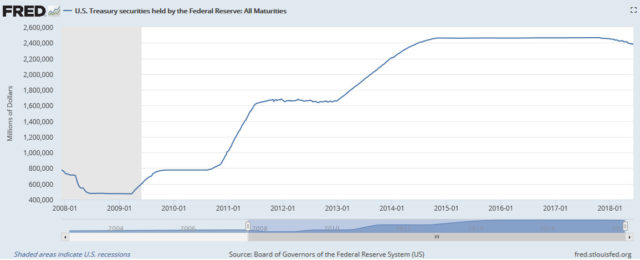The US Federal Reserve, much to nobody’s surprise, raised interest rates another 0.25% for a target rate of 1.75-2.00%.
In the implementation note, they also stated the interest to be paid on bank reserves would be 1.95%, which is a departure from the usual top of the range (2%) by 5 basis points. This will probably pin the effective short-term rate at 1.95% instead of at 2%.
The other news, which is equally not surprising, is an increase in the repurchase amounts of treasury and mortgage-backed securities held by the reserve:
The Committee directs the Desk to continue rolling over at auction the amount of principal payments from the Federal Reserve’s holdings of Treasury securities maturing during June that exceeds $18 billion, and to continue reinvesting in agency mortgage-backed securities the amount of principal payments from the Federal Reserve’s holdings of agency debt and agency mortgage-backed securities received during June that exceeds $12 billion. Effective in July, the Committee directs the Desk to roll over at auction the amount of principal payments from the Federal Reserve’s holdings of Treasury securities maturing during each calendar month that exceeds $24 billion, and to reinvest in agency mortgage-backed securities the amount of principal payments from the Federal Reserve’s holdings of agency debt and agency mortgage-backed securities received during each calendar month that exceeds $16 billion. Small deviations from these amounts for operational reasons are acceptable.
This quota (currently $18 billion in treasuries and $12 billion in mortgage-backed securities per month) has been continually rising every quarter. Now this will be $24 billion and $16 billion per month, respectively.
As you can see by very far right-hand side within the chart above, the amounts involved are still a drop in the bucket – between July and September will be another USD$120 billion removed. But the slope of the curve, every quarter, will continue to get steeper and steeper.
Although short-term interest rates are still exceptionally low from a historical perspective, without a doubt the monetary situation is going to create an increasing headwind. This is akin to running on the treadmill and adjusting the elevation from flat to a 1% incline – while the running is still relatively easy, it takes a bit more energy to achieve the same distance. For each increment that the Federal Reserve raises rates, the incline gets higher and higher and eventually you’ll have to stop and catch your breath.
That’s probably the ideal time to invest again. Until then, safety and capital preservation is the name of the game.
Finally, my other comment is that I would view it as more probable than not that the Bank of Canada will match the Federal Reserve’s rate increase on their July 11th meeting.
